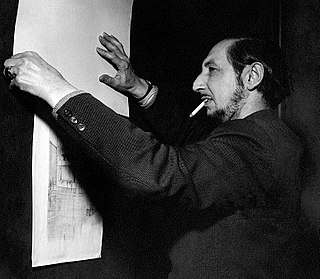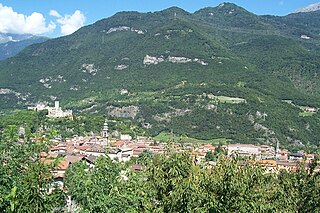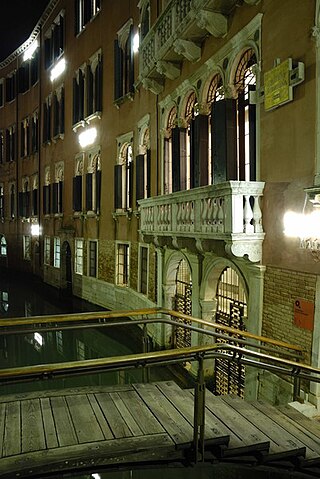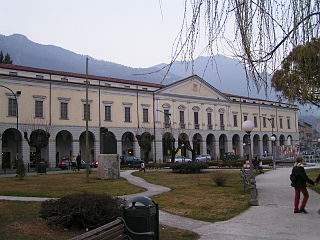
Andrea Mantegna was an Italian painter, a student of Roman archeology, and son-in-law of Jacopo Bellini.

BartolomeoMontagna was an Italian Renaissance painter who mainly worked in Vicenza. He also produced works in Venice, Verona, and Padua. He is most famous for his many Madonnas and his works are known for their soft figures and depiction of eccentric marble architecture. He is considered to be heavily influenced by Giovanni Bellini, in whose workshop he might have worked around 1470. Benedetto Montagna, a productive engraver, was his son and pupil and active until about 1540. He was mentioned in Vasari's Lives as a student of Andrea Mantegna but this is widely contested by art historians.

Pisanello, born Antonio di Puccio Pisano or Antonio di Puccio da Cereto, also erroneously called Vittore Pisano by Giorgio Vasari, was one of the most distinguished painters of the early Italian Renaissance and Quattrocento. He was acclaimed by poets such as Guarino da Verona and praised by humanists of his time, who compared him to such illustrious names as Cimabue, Phidias and Praxiteles.

Carlo Scarpa was an Italian architect, influenced by the materials, landscape and the history of Venetian culture, and by Japan. Scarpa translated his interests in history, regionalism, invention, and the techniques of the artist and craftsman into ingenious glass and furniture design.

Breno[ˈbreːno] is an Italian comune of 4,986 inhabitants in Val Camonica, province of Brescia, in Lombardy.

The Fondazione Querini Stampalia is a cultural institution in Venice, Italy, founded in 1869 at the behest of the last descendant of the Venetian Querini Stampalia family, Conte Giovanni Querini. Architect Carlo Scarpa designed interior, exterior, and garden elements and spaces on the ground floor of the historic building.

The Museo Correr is a museum in Venice, northern Italy. Located in St. Mark's Square, Venice, it is one of the 11 civic museums run by the Fondazione Musei Civici di Venezia. The museum extends along the southside of the square on the upper floors of the Procuratorie Nuove. With its rich and varied collections, the Museo Correr covers both the art and history of Venice.

Antonio Balestra was an Italian painter of the Rococo period.

Girolamo dai Libri was an Italian illuminator of manuscripts and painter of altarpieces, working in an early-Renaissance style.

Antonio d'Enrico, called Tanzio da Varallo, or simply il Tanzio was an Italian painter of the late-Mannerist or early Baroque period.
The decade of the 1470s in art involved some significant events.
The decade of the 1450s in art involved many significant events, especially in sculpture.

Francesco Bonsignori, also known as Francesco Monsignori, was an Italian painter and draughtsman, characterized by his excellence in religious subjects, portraits, architectural perspective and animals. He was born in Verona and died in Caldiero, a city near Verona. Bonsignori's style in early period was under the influence of his teacher Liberale da Verona. After becoming the portraitist and court artist to the Gonzaga family of Mantua in 1487, his style was influenced by Andrea Mantegna, who also worked for Francesco Gonzaga from the 1480s. They collaborated to execute several religious paintings, mainly with the theme of Madonna and Child. The attribution of theportrait of a Venetian Senator was debatable until the last century because of the similarity in techniques used by Bonsignori and his teacher Mantegna. During the phase of his career in Mantua, there is an undocumented period between 1495 and July 1506 with no official record regarding his activities by the court of Mantua. Bonsignori's late style was decisively influenced by Lorenzo Costa in terms of form and color. He produced his last monumental altarpiece the Adoration of the Blessed Osanna Andreasi in 1519 shortly before his death.

The Madonna of the Quail is an International Gothic painting generally attributed to Pisanello. Dating to c. 1420, it was housed in the Castelvecchio Museum of Verona, northern Italy until stolen in 2015. It would be recovered in 2016.

Turone was an Italian architect, painter and illuminator, active in the Veronese area in the second half of the 14th century.

San Paolo in Campo Marzio is a Roman Catholic church in Verona, region of Veneto, Italy.

Madonna and Child is a c.1475 tempera on panel painting by Giovanni Bellini, now in the Museo di Castelvecchio in Verona. It measures 77 cm by 57 cm.

The Accademia Tadini is a museum and art gallery, as well as an academy of both visual arts and music in Lovere, Province of Bergamo, Italy. It is located on Via Tadini #40, facing the shores of Lago d'Iseo.
The Muselli collection was one of the most notable art collections in 18th century Italy and - with the Gusti and Curtoni collections - a highlight of modern collecting in Verona.

























